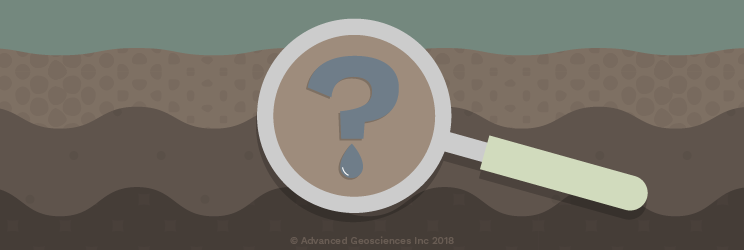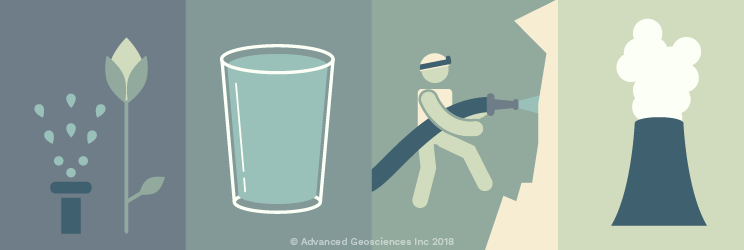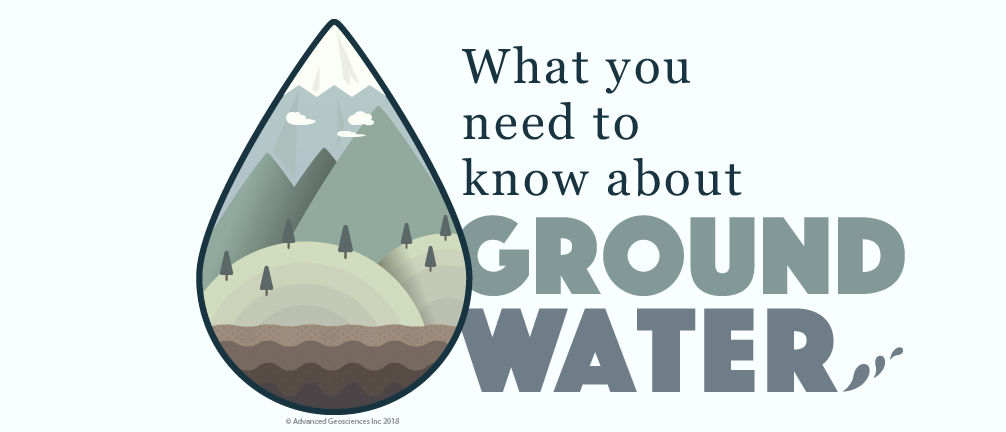• What is Groundwater?
In simplest terms, groundwater is the water present beneath the Earth's surface. Pretty straightforward, right? It's stored in porous soil, rock, and sediment called an aquifer.
So, how does the water get in the ground
When it rains, soil absorbs rainwater. The rainwater travels deep underground until it hits an existing water table or impermeable barrier. This is how it becomes part of an aquifer. Here’s a quick mental image:
Imagine a can filled with rocks and soil. Now fill that can with water and you have a basic simulation of what an aquifer is. The very top of your imaginary saturated can would be the water table.

Of course, not all water makes it down to these depths. Usually, rainwater that doesn’t become groundwater has:
Run off of soil into larger bodies of water, such as streams or lakes.- Puddled on non-porous surfaces like metal, plastic, clay, dense soil or concrete
- Been sucked up by the roots of plants and released to the air via the process of transpiration.
• Where is Groundwater found?
Aquifers filled with groundwater are all over the planet. In the United States alone, there are over a dozen major aquifers* (Source: The U.S. Geological Survey). There are also aquifer systems—interconnected aquifers spanning thousands of miles. There’s a good chance that wherever you’re reading this right now is above some source of groundwater. Aquifers and saturated zones are major sources. Unsaturated zones have some moisture in the soil, but not enough to for useful purposes.
According to the U.S. Geological Survey’s Water Census* (Source), some of the major aquifers/aquifer systems in the United States are:
- The High Plains Aquifer - Spans across parts of Texas, Oklahoma, Kansas, and most of Nebraska.
- The Basin and Range Basin-fill Aquifers - Spans across parts of New Mexico, Arizona, California, Utah, Idaho, Oregon, and most of Nevada.
- The Coastal Plains Aquifer System - This is a system of aquifers that connect to each other and spans across parts of several states.
- The Edwards-Trinity Aquifer System - Ok, so we’re a little biased because this system spans most of our home state of Texas. That said, it’s still a pretty large aquifer system spanning across parts of Texas, Oklahoma, and Arkansas.
As you can see, groundwater is ubiquitous. Even so, there are some pretty surprising places where you can find groundwater.
• How is Groundwater found?

You'd be surprised how easy it is to find groundwater—or at least the general location of it. If you want a broad sense of where you can find shallow groundwater (meaning it’s not too far underground), look to your nearest body of water. Your local streams, springs, lakes, marshes, etc., usually seep a bit below the surface. Other environmental cues are valleys and water-loving plants such as cottonwoods or willow* (Source: The U.S. Geological Survey).
These are simple methods to detect the presence of groundwater. If you want more accuracy (i.e; if you want to know exactly where and how much groundwater is present), you’re going to need to break out some geophysical scanning tools.
Of course, we here at AGI favor using the Electrical Resistivity Imaging (ERI) geophysical method to find groundwater. This isn’t because we’re experts in the method (though, that helps). We prefer this method because it delivers the most successful data of what’s below the earth’s surface. It’s also insensitive to noise, and data collection is not prone to human error.
Groundwater is usually more conductive than the surrounding host rock. ERI takes advantage of this to find and map it. In some cases, we look for sand and aggregate channels which contain water. In other cases, we look for impermeable layers like clay and shale that may trap water. But we could go on all day about ERI, let's move on.
• How is Groundwater collected?
In some instances, groundwater will discharge from the surface. When this happens, it becomes a spring. Before humans could drill deep below the earth, we collected groundwater from springs. Springs are a rare convenience though.
If a spring wasn't nearby, we would dig a good old-fashioned hole until we hit a water table with freshwater. Once we found groundwater in a hole, we constructed a well and/or water pump to collect the precious H20.
In our modern age, we humans have become far more efficient in collecting groundwater. We have accurate geophysical methods such as ERI to find aquifers deep underground. We also have sophisticated drilling programs to tap into those aquifers for collection.
• What is Groundwater used for?

As you may have guessed, a common use for groundwater is for drinking. However, not all groundwater is freshwater—or even potable. In these cases, we have found several other uses for groundwater, including:
- Agriculture and irrigation
- Architectural uses such as mixing cement and building materials
- Mineral mining*
- Thermoelectric power*
• Can Groundwater be dangerous?
To be fair, anything has the potential to be dangerous (even a geophysicist). So yes, in some cases groundwater has the potential to be dangerous.
For example, an aquifer can become polluted by improper waste disposal, chemicals, or other pollutants that can seep into the soil. Even saltwater can taint potable groundwater if it manages to permeate a freshwater aquifer.
In other instances, depleted groundwater can pose a danger. Full aquifers have a certain
Imagine a tall glass that's almost filled to the top with crushed ice and water. This will be our imaginary aquifer—with the ice playing the part of rocks and sediment. Now, top the glass off with soil (Just stick with us here). Place a straw in your glass to act as your well or water pump. Now suck the water out of the glass (Remember, this is imaginary—don't try this at home).
What happens when the water leaves the glass? The crushed ice shifted around a bit, right? The soil on top dipped a bit in certain areas too. Though the ice can support most of the soil, the water definitely helped carry the load.
This is one example of subsidence. There are several more, but we'll get to that in another educational series down the road.
• Is Groundwater Valuable?

Highly. In Texas, we have a saying “Whiskey is for drinking and water is for fighting.” Groundwater is one of the most important natural resources we have. As mentioned above, we not only use it for drinking, but agriculture, energy generation, and construction as well. In the western world with good infrastructures, running water is commonplace, so it's easy to take for granted.
Yet there are parts of the world that struggle to collect groundwater. This could be due to pollution, drought, over-tapped aquifers, or other problems. Helpful organizations strive to keep groundwater sustainable. We've worked with 4africa (Formerly The Radler Foundation), to provide freshwater resources to desperate areas like war-torn South Sudan. The Groundwater Foundation is another organization that strives to keep groundwater accessible.



